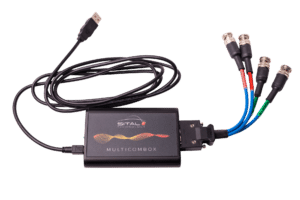USB – MultiComBox
Multi-I/O USB Tester - For all Protocols

Sital Technology’s TST1553USB MultiComBox provides full MIL-STD-1553B test, simulation and bus analysis capability in a compact self-contained unit. It connects over a USB 2.0 interface to any host system and operates from USB power. The Software comes with Sital’s COMposer GUI software, along with Windows API/library/driver software.
To support varying test requirements, the MultiComBox is available with many different mixes of I/Os and other options. These are described by the following paragraphs.
MIL-STD-1553. The MultiComBox can be supplied with either one or two dual redundant MIL-STD-1553 channels. These channels support independent or simultaneous Bus Controller (BC), up to 31 Remote Terminals (RT) and Bus Monitor (MT) operation. The MultiComBox can operate with a combination of internally simulated RTs and external RTs.
The MIL-STD-1553 interfaces can send and receive all formats of 1553 messages, including all mode codes. Controllable through either the COMposer GUI software or via its Windows API/library/driver, the BC can be programmed to control all message timing, including designating minor and major frame times for message transmission. The MultiComBox BC can also be programmed to transmit asynchronous messages outside of the minor and major frame schedule. For its multi-RT operation, RT Status words are fully programmable, including in real time.
Full error injection capability is available in BC and RT modes, with full error detection provided in BC, RT and MT modes. The MultiComBox’s emulated BCs and RTs may be programmed to inject sync and Manchester encoding errors, zero-crossing errors, gap errors, and high and low bit count errors and word count errors into 1553 messages.
ARINC-429. The MultiComBox includes an option for two ARINC-429 transmit channels and two receive channels. The ARINC-429 standard provides half-duplex communication over a one-to-one or one-to-many broadcast topology. ARINC-429 transmissions are 32 bits long and consist of an 8-bit Label, which identifies the data type (BNR, BCD, discrete); the equipment and source of the data; an optional 2-bit Source/Destination Identifier (SDI) field than can indicate the source or intended receiver of a message; a 19-bit data field; a Sign/Status Matrix (SSM) defining the mode of operation; and a parity bit.
EBR-1553. The MultiComBox tester includes an option for EBR-1553. The MultiComBox’s EBR-1553 architecture includes a BC/RT/Monitor and a 4-port hub. EBR-1553 operates with the same protocol as MIL-STD-1553, but with a data rate of 10 Mb/s. Instead of operating over a multi-drop bus, EBR-1553 operates over a series of point-to-point links using an RS-485 physical level (transceivers). The MultiComBox’s EBR-1553 interfaces are capable of injecting and detecting the same repertoire of error conditions as its MIL-STD-1553 channels. In terms of software, Sital’s EBR-1553 tester interface operates through the same API as the MultiComBox’s MIL-STD-1553 channels and may also be controlled by the COMposer GUI.
COMposer GUI Software. MultiComBox is supplied with Sital’s COMposer Windows GUI software. COMposer includes setup menus supporting full operation of the tester without needing to write software code.
For BC mode, COMposer includes message and frame setup screens for creating BC messages to transmit and for designating all message parameters. For BC operation, the user can program BC minor and major frames and also transmit asynchronous messages. It’s also possible to designate specific error types to inject in individual messages. In BC “Run” mode, the user can run the programmed BC frame once, “N” times or continuously. The COMposer BC also provides capabilities to load and run pre-defined test sequences; control the MultiComBox’s EBR-1553 BC and 4-port hub; and to load and run a previously recorded frame.
For RT mode, the user can designate which of the 31 RT addresses to simulate, and program the values of individual’s RT Status words.
For both BCs and RTs, COMposer includes capability for cyber-attack emulation. This verifies the operation of Sita’s Safe and Secure (SnS) operation by emulating “spoofing” BC or RTs.
The COMposer Monitor can store either all messages or a programmable subset of RT, T-R bit and subaddress combinations. With the COMposer Monitor, the user can create custom chart and gauge displays. For these, monitored 1553 data can be displayed in engineering units. The GUI provides capability for users to program parameter names, numerical types, type of units, scale, offset and display range. In addition, the COMposer Monitor can display all received messages, record monitored data and playback previously recorded data.
Windows API/library/driver Software. The MultiComBox API/library/driver software consists of over 70 function calls for controlling and monitoring traffic for MIL-STD-1553, ARINC-429, 16PP194, H009, RS-485 and EBR-1553/1760 data buses. The API includes functions for programming messages, data blocks, bus lists and frames; asynchronous messages; reading monitored data, including descriptors for individual messages; simulating RTs with programmable response time delays; periodic cyber resiliency attack based on time or triggering commands; and performing external loopback tests. The API’s manual includes sample programs for various interface types and modes.
RS-485/422. RS-485 and RS-422 are physical layer serial interface standards. The MultiComBox tester includes an option for 4 channels that can each be configured for either RS-485 half-duplex communication over either a point-to-point connection or multi-drop bus; or RS-422 simplex communication, also over either a point-to-point connection or multi-drop bus.
H009. The MultiComBox includes an option for a single H009 channel. Sital’s implementation of H009 provides software API compatibility with the MultiComBox MIL-STD-1553 tester channels.
The H009 standard was developed by McDonnell Douglas in the late 1960s for use on F-15 avionics systems and involves two-way transmission over a pair of data buses between a CCC (Central Computer Complex) and one or more remote units referred to as peripherals. The two data buses include a differential 1 MHz clock signal provided by the CCC, along with dual redundancy of the clock and data buses.
16PP194. The MulticomBox also includes an option for one dual redundant channel of
16PP194. Sital’s 16PP194 architecture provides software compatibility with its MIL-STD-1553 API. The 16PP194 standard, aka Weapons Mux or WMUX, was developed by General Dynamics in the mid-1970s. It’s used alongside MIL-STD-1553 on F-16 stores (weapons) buses.
The 16PP194 standard calls for two types of terminals, a CIU (Control Interface Unit) and a one or more RIUs (Remote Interface Units). The topology of the 16PP194 standard consists of two separate unidirectional (simplex) data buses, one for message transmissions from the CIU (Control Interface Unit) to the RIUs, and the second one for transmissions from RIUs to the CIU. 16PP194 also calls for redundancy, with a backup data bus. The 16PP194 standard calls for a 26-bit word format, with data, status and GO/NOGO words; and 4 μS gaps between words. The 26-bit word includes a sync bit, 4-bit RIU address and subaddress fields, a 16-bit data field and a parity bit with odd parity.
IRIG-B Time Input and Output. The MulticomBox provides an option to accept an IRIG-B time input signal and provide an IRIG-B output signal. For its IRIG-B input, the MultiComBox supports the following two formats:
- B006: 100 PPS update rate, 1 ms resolution; no carrier; BCDTOY, BCDYEAR encoding
- B126: 100 PPS update rate, 1 ms resolution; analog sine wave, amplitude modulated; 1 kHz carrier, 1 ms carrier resolution; BCDTOY, BCDYEAR encoding
For its IRIG-B output, the MultiComBox supports the following format:
- B006: 100 PPS update rate, 1 ms resolution; no carrier; BCDTOY, BCDYEAR encoding
Sital Safe and Secure (SnS). For its MIL-STD-1553 channels, the MultiComBox provides an option for Sital’s Safe and Secure (SnS) technology. By means of enhanced physical layer signal monitoring, Sital’s SnS is able to detect instances of cyber authentication violations; that is, instances of “spoofing” BCs or RTs impersonating the BC or RT that’s normally transmits in a specific time window. Sital’s SnS can also detect and locate intermittent open and short circuit wire faults in 1553 bus and stub cables, connectors, couplers, terminators and connected LRUs.
Cyber Resilience Testing. The MultiComBox provides an option for cyber resiliency testing. This feature provides a means for testing Sital’s Safe and Secure (SnS) capability for detecting “spoofing” (impersonating or attacking) BCs and RTs on MIL-STD-1553 buses. This involves the capability to transmit messages that emulate spoofing BCs and RTs executing cyberattacks.
The MultiComBox’s cyber resiliency testing includes multiple methods for scheduling the transmission of the spoofing messages. These include simulating spoofing BC messages after waiting a predefined time period following a bus idle condition on both Bus A and Bus B. The attacking BC will then transmit messages persistently, based on a programmable periodicity parameter. Alternatively, a cyber-attack may be triggered by waiting for the normal BC to transmit a particular command “N” times.
It’s also possible to program an RT to transmit spoofing responses. This includes capability to vary the response time of the emulated attacking RTs, periodic cyber resiliency attack based on time, or attacks based on specific triggering commands.
Two-channel Oscilloscope Option. The MultiComBox includes an option for a two-channel oscilloscope. The two-channel scope provides capability for visually monitoring MIL-STD-1553, RS-485, EBR-1553 and ARINC-429 signals. In addition to programming the type (protocol) of data to be monitored, the oscilloscope includes programmability for other parameters. These include time and voltage scaling; triggering; display live or frozen data; and capabilities to accurately measure signal amplitudes and pulse widths.
- Support multiple IP Cores: MIL-STD-1553B, H009, PP194, EBR 1553, ARINC 429, RS-485, RS-422
- Up to two channels Mil-Std-1553B Bus tester
- Up to 4 ARINC429 channels
- Up to 4 EBR1553 channels
- IRIG-B Discrete Receive Line for external clock sync
- Passive TDR capabilities for MIL-STD-1553B for real-time circuit fault detection
- Cyber resilience testing for MIL-STD-1553B/1760 with multiple attack modes.
- Suitable for any MIL-STD-1553B BC, RT, MT testing· USB 2.0 interface to PC, Allows real time tester control
- Optional 4 channels of RS-422 for additional testing capabilities
- Works on USB power. No need for external power source
- Multiple RT simulation (up to 31 RTs)
- Support for asynchronous messaging from the COMposer application and API for real-time message simulation
- Loop-back & Live mode generates live RT data
- Programmable Status word and Mode Code
- Error injection and detection
- Time tagging for each message
- Message Scheduling changeable in real time
- Data and Status words changeable in real time
- New and compact Rate-Mode message-per-frame scheduling
- Optional MuxView® software for traffic generation and analysis
- Optional RTs’ analog connection status reporting
- ANSI C API and Windows/Linux kernel drivers for embedding with any test application
- Engineering Units Support






